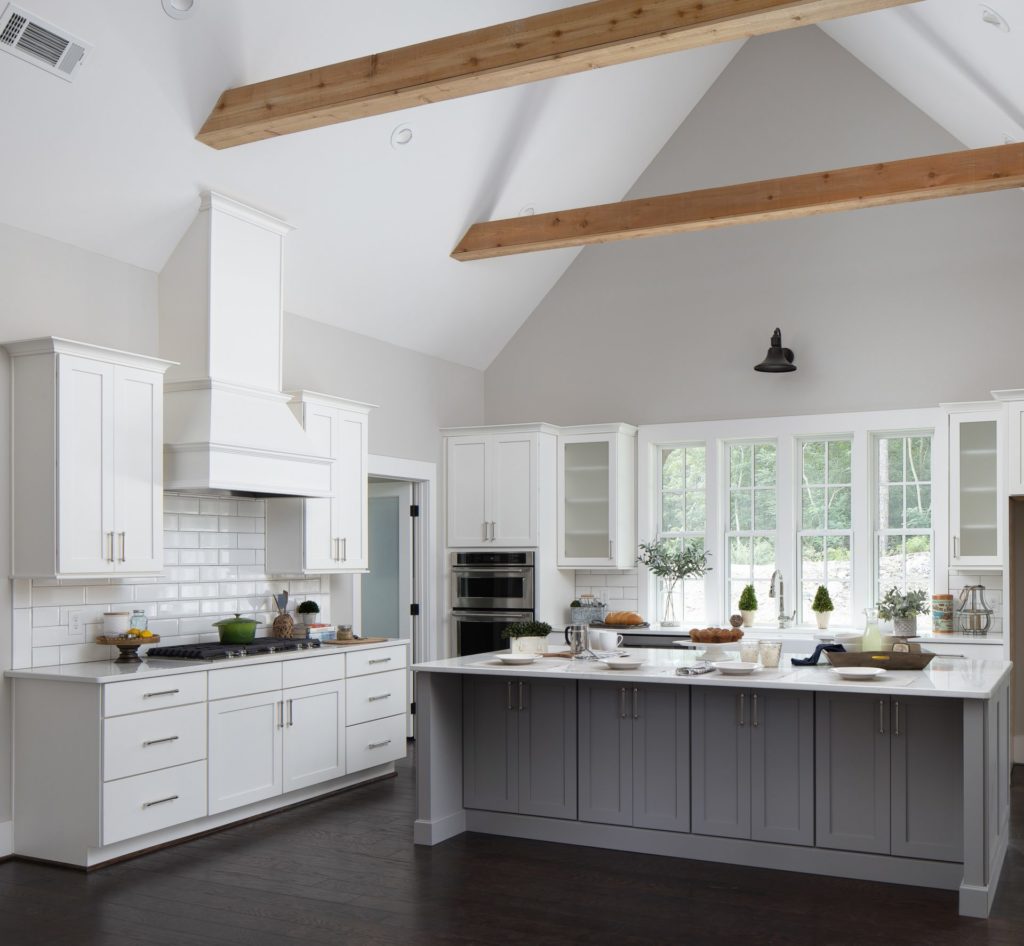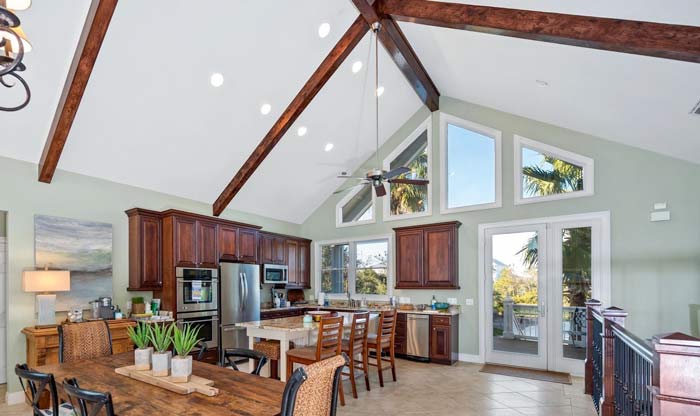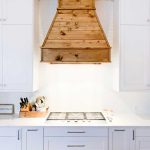To install a range hood on a vaulted ceiling, first, locate the area for installation and then use a support brace to secure the hood. Installing a range hood on a vaulted ceiling can be challenging.
A range hood helps in removing smoke, steam, and cooking smells from your kitchen. It is crucial to have adequate ventilation in your kitchen as cooking fumes can be hazardous to your health. If your ceiling is vaulted, you’ll need to make some necessary changes before installing your range hood.
It’s important to have the right materials and tools to make the installation process easy. This article will provide you with a step-by-step guide to help you install a range hood on a vaulted ceiling.

Credit: jwrightbuildingcompany.com
Understanding The Basics Of Range Hood Installation On Vaulted Ceiling
What Is A Range Hood?
A range hood is an appliance in the kitchen that helps to remove smoke, steam, heat, and cooking odors produced during cooking. It is placed above gas stoves or cooktops and serves as an exhaust system.
Why Is It Important To Install A Range Hood On Your Vaulted Ceiling?
Installing a range hood on your vaulted ceiling is essential for several reasons. Here are some of them:
- It improves ventilation in your kitchen by removing harmful pollutants such as carbon monoxide, airborne grease, fumes, and excess heat.
- It helps to prevent moisture build-up on your ceiling and walls that can cause damage, mold, and mildew.
- It minimizes the risk of kitchen fires by removing flammable grease and steam.
- It enhances the quality of the air inside your kitchen, making it healthier and more comfortable for you and your household.
Different Types Of Range Hoods
There are different types of range hoods available in the market. Here are some of them:
- Wall-mounted range hoods: These are attached to the wall and are ideal for kitchens with no cabinets above the cooktop.
- Island range hoods: These are perfect for cooking islands and have vents that hang from the ceiling.
- Under cabinet range hoods: These are installed under the cabinet above the cooktop and are ideal for kitchens with limited space.
- Downdraft range hoods: These have vents located at the back of the cooktop that pull smoke and fumes down from the surface.
Each type of range hood has its advantages and disadvantages. It is essential to understand the differences and choose the one that best suits your kitchen’s needs.
Remember, installing a range hood on your vaulted ceiling requires careful planning, precise measurements, and proper installation. By following the manufacturer’s instructions and professional advice, you can install a range hood that improves your kitchen’s ventilation and enhances your cooking experience.
Preparing For The Installation
Installing a range hood on a vaulted ceiling can be a challenging task, especially if you have never done it before. However, with the right tools, materials, and some preparation, you can do it yourself at home. Here are the key steps you need to take to prepare for the installation.
Tools And Materials Required For The Installation
Before you start the installation, you should have the following tools and materials ready:
- A range hood kit that you have already purchased
- A ladder or step stool that is tall enough to allow you to reach the ceiling
- A pencil or marker to make measurements on the ceiling
- A drill and drill bits for making holes in the ceiling
- A stud finder for locating the support beams in the ceiling
- Screws and anchors to secure the range hood to the ceiling
- Ductwork and venting materials for connecting the range hood to the outside
Safety Precautions To Follow During The Installation
As you prepare for the installation, it’s essential to prioritize your safety. Here are some precautions you should follow:
- Always wear protective gear like safety goggles and gloves.
- Turn off all electrical power to the range hood and circuit breakers before you begin working.
- Be careful when working on the ladder or step stool, so they don’t tip over.
- Avoid hitting the support beams when drilling into the ceiling.
- Follow the manufacturer’s instructions and seek professional help if you’re not confident about the installation.
Selecting The Right Spot For Installing The Range Hood
Choosing the right spot to install your range hood is a crucial step in the installation process. Here’s how you can do it:
- Consider the layout of your kitchen and where your range is located.
- The range hood should be installed at least 24 inches above the cooktop or range.
- Identify the support beams in your ceiling to ensure the range hood can be securely attached.
- Make sure the location you choose has access to ductwork and ventilation for efficient airflow.
- Be mindful of any decorative features, like ceiling fans or light fixtures in your kitchen, which could be obstructed by the range hood.
By following these steps to prepare for the installation, you’ll be one step closer to successfully installing your range hood on a vaulted ceiling. Remember to prioritize safety, read the instructions carefully, and seek additional help if you’re uncertain about any step.
Step-By-Step Guide To Installing Range Hood On Vaulted Ceiling
Step 1: Measuring The Space For The Range Hood
Installing a range hood on a vaulted ceiling can seem a daunting task. But fear not, with proper planning and some elbow grease, it can be an easy job. The first step is to measure the space for the range hood.
- Use a ladder to reach the top of the vaulted ceiling.
- Measure the width and height of the range hood to ensure it fits the space.
- Make sure there is enough space to install the duct and vent.
Step 2: Cutting The Hole In The Ceiling
The next step is to cut a hole in the ceiling for the range hood exhaust.
- Use a stud finder to locate the rafters in the ceiling.
- Mark the center point on the ceiling where the range hood will be installed.
- Cut a hole using a reciprocating saw that is slightly larger than the duct fitting.
Step 3: Installing The Duct And Vent
After cutting the hole, it’s time to install the duct and vent.
- Attach the duct to the range hood and feed it through the hole in the ceiling.
- Connect the duct to the vent with screws and tape.
- Make sure the duct is level and secure.
Step 4: Mounting The Range Hood On The Ceiling
The fourth step is to mount the range hood on the ceiling.
- Install the mounting bracket to the ceiling with screws.
- Hang the range hood on the bracket and adjust it to be level.
- Secure the range hood to the bracket with screws.
Step 5: Electrical Wiring And Connecting The Range Hood
The final step is to connect the range hood to the electrical wiring.
- Turn off the power to the electrical circuit for safety.
- Run electrical wiring from the range hood to the electrical box in the ceiling.
- Connect the wiring and secure it with wire nuts.
- Turn on the power to test the range hood.
There you have it, a step-by-step guide to installing a range hood on a vaulted ceiling. Follow these guidelines, and you’ll be breathing easy knowing you have a properly installed ventilation system in your kitchen.
Common Challenges And How To Overcome Them
Range hoods are an essential component of any kitchen, providing ventilation that helps to remove unwanted odors, smoke, and grease from the air. However, installing a range hood on a vaulted ceiling can be a challenging task. In this section of the blog post, we’ll discuss the common challenges you may face when installing a range hood on a vaulted ceiling and how to overcome them.
Dealing With Uneven Or Sloping Ceilings
Vaulted ceilings can be uneven or sloping, which can make it difficult to install a range hood. Here are some key points to keep in mind when dealing with uneven or sloping ceilings:
- Before installing a range hood, make sure to measure the height of your ceiling. This will ensure that you choose a range hood that fits your space and can be properly installed.
- If your ceiling is uneven, you may need to use shims or other leveling materials to ensure that the range hood is installed evenly.
- If your ceiling is sloping, you may need to install the range hood at an angle to ensure that it is properly aligned.
- It’s important to make sure that the range hood is securely attached to the ceiling using the appropriate hardware.
Addressing Ventilation Problems
Proper ventilation is essential when installing a range hood on a vaulted ceiling. Here are some key points to keep in mind when addressing ventilation problems:
- Make sure that the range hood is properly vented to the outside. This will help to ensure that grease and odors are properly filtered out of the air.
- If you don’t have access to an exterior vent, consider using a recirculating range hood. This type of range hood uses filters to remove grease and odors from the air before recirculating it back into the room.
- If you’re experiencing poor ventilation, check to make sure that the vent ducts are properly installed and free of obstructions. Cleaning the filters regularly can also help to improve ventilation.
Choosing The Right Range Hood For Your Kitchen
Choosing the right range hood is important when installing one on a vaulted ceiling. Here are some key points to keep in mind when making your selection:
- Choose a range hood that is appropriate for the size of your kitchen. A larger kitchen may require a more powerful range hood to properly ventilate the space.
- Consider the style of your kitchen when choosing a range hood. A range hood that matches the style of your kitchen can help to create a cohesive look.
- Make sure to choose a range hood that is properly sized for your space. This will ensure that it can be properly installed and effectively remove smoke and odors from the air.
Installing a range hood on a vaulted ceiling requires careful planning and execution. By following the key points outlined in this section of the blog post, you can help to ensure that your range hood is properly installed and provides effective ventilation for your kitchen.
Maintenance And Cleaning Of Range Hood
Installing a range hood on a vaulted ceiling can be challenging but maintaining and cleaning it can be even more daunting. However, regular cleaning is crucial for the range hood to work efficiently and maintain its longevity. In this section, we will discuss the importance of regular maintenance and cleaning, tips and best practices for cleaning a range hood on a vaulted ceiling, and common problems to watch out for and how to fix them.
Importance Of Regular Maintenance And Cleaning
Regular maintenance and cleaning of your range hood on a vaulted ceiling are essential for its longevity and durability. Failure to clean it can lead to an accumulation of grease, which can cause a fire hazard. A poorly maintained range hood can also reduce its efficiency, leading to an increase in noise and a decrease in air quality.
In addition, a well-maintained range hood saves you money on utility costs by operating efficiently.
Tips And Best Practices For Cleaning Range Hood On Vaulted Ceiling
Cleaning a range hood on a vaulted ceiling can be challenging, especially if it hasn’t been maintained as it should be. Here are some tips and best practices for cleaning a range hood on a vaulted ceiling:
- Turn off the power source before cleaning the range hood to prevent electrical shock.
- Remove the filters and wash them with soap and warm water. You can also soak them in a mixture of water and vinegar to remove the grease buildup.
- Clean the range hood’s exterior with a non-abrasive cleaner and a soft cloth to avoid scratches on its surface.
- Pay particular attention to the range hood’s grease trap, which can quickly accumulate a significant amount of grease.
- Use a degreaser to clean the interior exhaust system of the range hood.
- Regularly check the duct and its connections to ensure that there is no blockage, detritus or obstructions.
- If you are unsure about the best practices for cleaning a range hood on a vaulted ceiling, refer to the manufacturer’s instruction manual.
Common Problems To Watch Out For And How To Fix Them
Despite regular maintenance and cleaning, a range hood on a vaulted ceiling may develop some common problems. Here are some examples and how to fix them:
- Loud noise: If your range hood is making a lot of noise, it may be due to a loose component, which can be tightened for a quieter operation.
- Ineffective operation: If your range hood isn’t operating correctly, check the duct and its connections to ensure no obstructions. You should also check the exhaust fan motor to ensure it is working correctly.
- Replacement of filters: It is recommended that you replace the range hood’s filters every 6-12 months, depending on usage. Failing to do so can affect its efficiency and performance.
- Power supply issues: If the range hood doesn’t turn on, check the power supply. Ensure that the fuse is correctly installed and that the plug isn’t corroded or burnt.
Regular maintenance and cleaning of a range hood on a vaulted ceiling are crucial for its longevity and efficiency. With the tips and best practices discussed above, cleaning it can be easier, and the issues that may arise can be quickly resolved.
Frequently Asked Questions On How To Install Range Hood On Vaulted Ceiling
How Do You Choose The Right Range Hood For A Vaulted Ceiling?
Choose a range hood that can accommodate the pitch of your ceiling. Look for models with adjustable chimney sections that can be extended or shortened to fit your ceiling’s height.
Can You Install A Range Hood On A Vaulted Ceiling Without Professional Help?
It’s possible to install a range hood on a vaulted ceiling without a professional, but it can be challenging. Make sure to research the process thoroughly and have all the necessary tools and materials before beginning the installation.
How Do You Mount A Range Hood On A Vaulted Ceiling?
First, locate and cut a hole in the ceiling for the vent pipe. Next, install a suitable support bracket and secure it to the ceiling’s framing. Finally, install the range hood according to the manufacturer’s instructions.
Can A Range Hood Be Installed Without Venting?
Yes, it’s possible to install a non-vented range hood in your kitchen. These models filter the air and recirculate it back into the room. However, they require regular filter replacements and may not be as effective as vented hoods in removing smoke and cooking odors.
How High Should A Range Hood Be Mounted Above The Stove On A Vaulted Ceiling?
The range hood should be mounted 28 to 36 inches above the cooking surface for best performance. If you have a vaulted ceiling, make sure to adjust the height accordingly. It’s recommended to consult the manufacturer’s guidelines for your specific model.
Conclusion
Installing a range hood on a vaulted ceiling can seem daunting at first, but with the right tools, preparation, and knowledge, it can be accomplished by anyone. Taking the time to measure and properly mount the hood, as well as properly venting and wiring it, will ensure that it is not only a functional appliance but also a safe one.
Remember, safety is always a priority, so if you feel uncomfortable with any part of the installation process, seek the help of a professional. By following these steps, you can have a range hood that will effectively remove cooking odors, smoke, and heat, while simultaneously adding an attractive element to your kitchen’s design.
Don’t let a vaulted ceiling deter you from installing a much-needed range hood in your kitchen – with a little patience and guidance, it’s easier than you think.

Freda is a passionate foodie and kitchen gadget enthusiast. With over 10 years of experience in the culinary industry, Freda brings her expertise in testing and reviewing kitchen gadgets.





